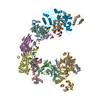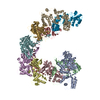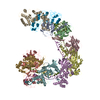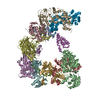+ Open data
Open data
- Basic information
Basic information
| Entry | Database: PDB / ID: 6pig | ||||||
|---|---|---|---|---|---|---|---|
| Title | V. cholerae TniQ-Cascade complex, closed conformation | ||||||
 Components Components |
| ||||||
 Keywords Keywords | RNA BINDING PROTEIN/RNA /  CRISPR/Cas / Cascade / CRISPR/Cas / Cascade /  RNA BINDING PROTEIN / RNA BINDING PROTEIN-RNA complex RNA BINDING PROTEIN / RNA BINDING PROTEIN-RNA complex | ||||||
| Function / homology |  RNA / RNA (> 10) RNA / RNA (> 10) Function and homology information Function and homology information | ||||||
| Biological species |   Vibrio cholerae (bacteria) Vibrio cholerae (bacteria) | ||||||
| Method |  ELECTRON MICROSCOPY / ELECTRON MICROSCOPY /  single particle reconstruction / single particle reconstruction /  cryo EM / Resolution: 3.5 Å cryo EM / Resolution: 3.5 Å | ||||||
 Authors Authors | Halpin-Healy, T. / Klompe, S. / Sternberg, S.H. | ||||||
 Citation Citation |  Journal: Nature / Year: 2020 Journal: Nature / Year: 2020Title: Structural basis of DNA targeting by a transposon-encoded CRISPR-Cas system. Authors: Tyler S Halpin-Healy / Sanne E Klompe / Samuel H Sternberg / Israel S Fernández /  Abstract: Bacteria use adaptive immune systems encoded by CRISPR and Cas genes to maintain genomic integrity when challenged by pathogens and mobile genetic elements. Type I CRISPR-Cas systems typically ...Bacteria use adaptive immune systems encoded by CRISPR and Cas genes to maintain genomic integrity when challenged by pathogens and mobile genetic elements. Type I CRISPR-Cas systems typically target foreign DNA for degradation via joint action of the ribonucleoprotein complex Cascade and the helicase-nuclease Cas3, but nuclease-deficient type I systems lacking Cas3 have been repurposed for RNA-guided transposition by bacterial Tn7-like transposons. How CRISPR- and transposon-associated machineries collaborate during DNA targeting and insertion remains unknown. Here we describe structures of a TniQ-Cascade complex encoded by the Vibrio cholerae Tn6677 transposon using cryo-electron microscopy, revealing the mechanistic basis of this functional coupling. The cryo-electron microscopy maps enabled de novo modelling and refinement of the transposition protein TniQ, which binds to the Cascade complex as a dimer in a head-to-tail configuration, at the interface formed by Cas6 and Cas7 near the 3' end of the CRISPR RNA (crRNA). The natural Cas8-Cas5 fusion protein binds the 5' crRNA handle and contacts the TniQ dimer via a flexible insertion domain. A target DNA-bound structure reveals critical interactions necessary for protospacer-adjacent motif recognition and R-loop formation. This work lays the foundation for a structural understanding of how DNA targeting by TniQ-Cascade leads to downstream recruitment of additional transposase proteins, and will guide protein engineering efforts to leverage this system for programmable DNA insertions in genome-engineering applications. | ||||||
| History |
|
- Structure visualization
Structure visualization
| Movie |
 Movie viewer Movie viewer |
|---|---|
| Structure viewer | Molecule:  Molmil Molmil Jmol/JSmol Jmol/JSmol |
- Downloads & links
Downloads & links
- Download
Download
| PDBx/mmCIF format |  6pig.cif.gz 6pig.cif.gz | 703.3 KB | Display |  PDBx/mmCIF format PDBx/mmCIF format |
|---|---|---|---|---|
| PDB format |  pdb6pig.ent.gz pdb6pig.ent.gz | 571.7 KB | Display |  PDB format PDB format |
| PDBx/mmJSON format |  6pig.json.gz 6pig.json.gz | Tree view |  PDBx/mmJSON format PDBx/mmJSON format | |
| Others |  Other downloads Other downloads |
-Validation report
| Arichive directory |  https://data.pdbj.org/pub/pdb/validation_reports/pi/6pig https://data.pdbj.org/pub/pdb/validation_reports/pi/6pig ftp://data.pdbj.org/pub/pdb/validation_reports/pi/6pig ftp://data.pdbj.org/pub/pdb/validation_reports/pi/6pig | HTTPS FTP |
|---|
-Related structure data
| Related structure data |  20350MC  6pifC  6pijC M: map data used to model this data C: citing same article ( |
|---|---|
| Similar structure data |
- Links
Links
- Assembly
Assembly
| Deposited unit | 
|
|---|---|
| 1 |
|
- Components
Components
-RNA chain , 1 types, 1 molecules 1
| #1: RNA chain | Mass: 19237.338 Da / Num. of mol.: 1 / Source method: obtained synthetically / Source: (synth.)   Vibrio cholerae (bacteria) Vibrio cholerae (bacteria) |
|---|
-Protein , 3 types, 8 molecules ABCDEFGH
| #2: Protein | Mass: 39020.035 Da / Num. of mol.: 6 Source method: isolated from a genetically manipulated source Source: (gene. exp.)   Vibrio cholerae (bacteria) / Production host: Vibrio cholerae (bacteria) / Production host:   Escherichia coli (E. coli) Escherichia coli (E. coli)#3: Protein | | Mass: 57064.711 Da / Num. of mol.: 1 Source method: isolated from a genetically manipulated source Source: (gene. exp.)   Vibrio cholerae (bacteria) / Production host: Vibrio cholerae (bacteria) / Production host:   Escherichia coli (E. coli) Escherichia coli (E. coli)#4: Protein | | Mass: 22926.184 Da / Num. of mol.: 1 Source method: isolated from a genetically manipulated source Source: (gene. exp.)   Vibrio cholerae (bacteria) / Production host: Vibrio cholerae (bacteria) / Production host:   Escherichia coli (E. coli) Escherichia coli (E. coli) |
|---|
-TniQ monomer ... , 2 types, 2 molecules IJ
| #5: Protein | Mass: 41517.160 Da / Num. of mol.: 1 Source method: isolated from a genetically manipulated source Source: (gene. exp.)   Vibrio cholerae (bacteria) / Production host: Vibrio cholerae (bacteria) / Production host:   Escherichia coli (E. coli) Escherichia coli (E. coli) |
|---|---|
| #6: Protein | Mass: 42315.031 Da / Num. of mol.: 1 Source method: isolated from a genetically manipulated source Source: (gene. exp.)   Vibrio cholerae (bacteria) / Production host: Vibrio cholerae (bacteria) / Production host:   Escherichia coli (E. coli) Escherichia coli (E. coli) |
-Experimental details
-Experiment
| Experiment | Method:  ELECTRON MICROSCOPY ELECTRON MICROSCOPY |
|---|---|
| EM experiment | Aggregation state: PARTICLE / 3D reconstruction method:  single particle reconstruction single particle reconstruction |
- Sample preparation
Sample preparation
| Component | Name: VC-Tn667 transposon encoded CRISPR/Cas effector / Type: COMPLEX / Entity ID: all / Source: RECOMBINANT | ||||||||||||||||||||
|---|---|---|---|---|---|---|---|---|---|---|---|---|---|---|---|---|---|---|---|---|---|
| Molecular weight | Value: 0.6 MDa / Experimental value: NO | ||||||||||||||||||||
| Source (natural) | Organism:   Vibrio cholerae (bacteria) Vibrio cholerae (bacteria) | ||||||||||||||||||||
| Source (recombinant) | Organism:   Escherichia coli (E. coli) Escherichia coli (E. coli) | ||||||||||||||||||||
| Buffer solution | pH: 7.2 | ||||||||||||||||||||
| Buffer component |
| ||||||||||||||||||||
| Specimen | Embedding applied: NO / Shadowing applied: NO / Staining applied : NO / Vitrification applied : NO / Vitrification applied : YES : YES | ||||||||||||||||||||
| Specimen support | Details: unspecified | ||||||||||||||||||||
Vitrification | Instrument: FEI VITROBOT MARK II / Cryogen name: ETHANE / Humidity: 100 % / Chamber temperature: 4 K |
- Electron microscopy imaging
Electron microscopy imaging
| Experimental equipment |  Model: Tecnai Polara / Image courtesy: FEI Company |
|---|---|
| Microscopy | Model: FEI POLARA 300 |
| Electron gun | Electron source : :  FIELD EMISSION GUN / Accelerating voltage: 300 kV / Illumination mode: OTHER FIELD EMISSION GUN / Accelerating voltage: 300 kV / Illumination mode: OTHER |
| Electron lens | Mode: BRIGHT FIELD Bright-field microscopy Bright-field microscopy |
| Image recording | Electron dose: 50 e/Å2 / Film or detector model: GATAN K3 (6k x 4k) |
- Processing
Processing
| Software | Name: REFMAC / Version: 5.8.0238 / Classification: refinement |
|---|---|
| EM software | Name: RELION / Version: 3 / Category: final Euler assignment |
CTF correction | Type: PHASE FLIPPING AND AMPLITUDE CORRECTION |
3D reconstruction | Resolution: 3.5 Å / Resolution method: FSC 0.143 CUT-OFF / Num. of particles: 87000 / Symmetry type: POINT |
 Movie
Movie Controller
Controller













 PDBj
PDBj





























